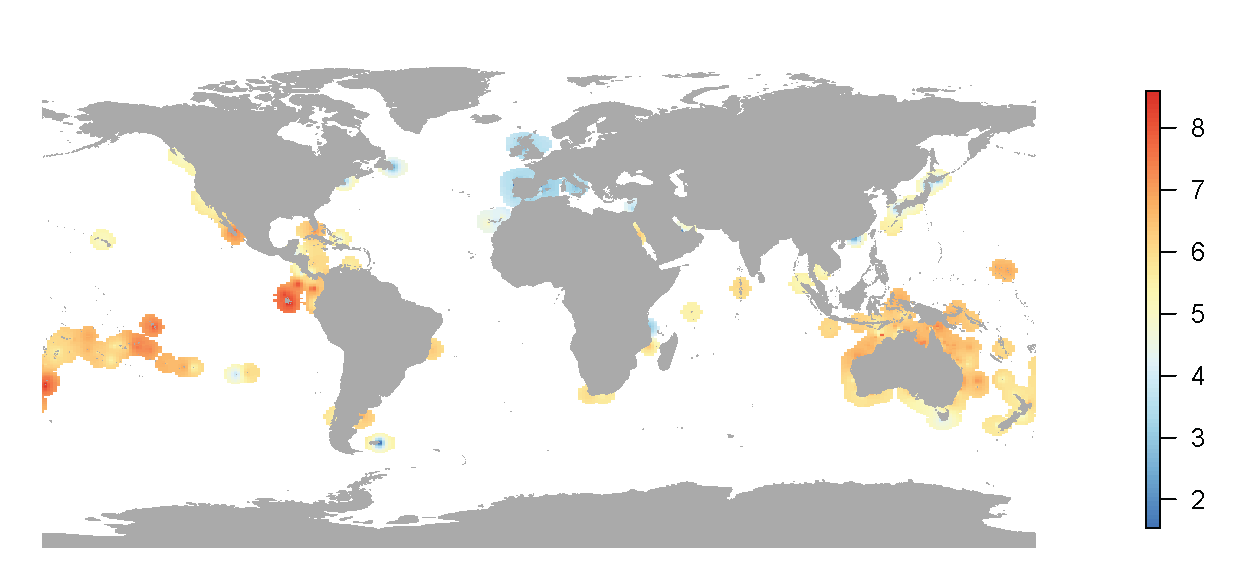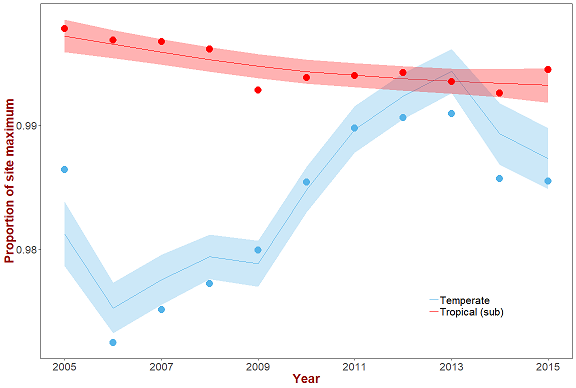Two Reef Life Survey indicators have been formally accepted by the Biodiversity Indicators Partnership (BIP) for reporting on global biodiversity targets: the biomass of all fishes on RLS surveys 20 cm and over, the Large Reef Fish indicator; and the community temperature index used for the reef fish community, the Reef Fish Thermal Index.
This is exceptional recognition of the quality and quantity of the data collected by RLS divers and international partners and its relevance to international policies and agreements.
The Biodiversity Indicator Partnership (BIP) is a global initiative that coordinates the development and delivery of biodiversity indicators used to report on targets and goals established by international conventions, organisations and governments. The indicators put forward by the BIP are the primary tools used to report on the progress and success of the Aichi Biodiversity Targets established by the Convention on Biological Diversity, and the United Nations’ Sustainable Development Goals (SDGs).
Other indicators provided by the BIP include the Living Planet Index, MSC Certified Catch, Red List Index, Ocean Health Index, and Live Coral Cover.

The Large Reef Fish Indicator is a measure of the biomass of reef fishes 20 cm or more in length and is based on the underwater survey data collected by RLS volunteers worldwide. It can be used to track changes in biodiversity in response to fishing, the effectiveness of marine protected areas (MPAs) and is also relevant to understanding climate impacts on fisheries opportunities in vulnerable reef habitats such as coral reefs or kelp forests.
The Large Reef Fish Indicator is now a primary indicator for Aichi Targets 6 (Fisheries), 10 (Vulnerable ecosystems) and 11 (Protected Areas) and is an indicator for the UN Sustainable Development Goal 14.2.
Notably, the Large Reef Fish indicator is also the only indicator informing CBD Aichi Target 6 and the SDG 14.2 which isn’t based on fisheries catch data.
The Reef Fish Thermal Index is calculated from comprehensive reef fish community structure data from underwater surveys by RLS volunteers. It is designed to assist in understanding climate impacts in vulnerable reef habitats – such as coral reefs or kelp forests – by quantifying changes in the make-up of reef fishes that result from local extinctions, immigration and/or shifting local abundance trends that can be readily linked to temperature.
The Reef Fish Thermal Index is essentially a typical "preferred" temperature of the fish species at a site. Therefore, a reduction in the Reef Fish Thermal Index at a site through time suggests either an increase in the proportion and abundance of cooler-water species, or a decrease in warmer-water species, or a combination of both.

Reef Life Survey is currently in the process of developing a new online data exploration tool to allow for live reporting of the Large Reef Fish Indicator and Reef Fish Thermal Index, as well as other aspects of the reef communities, for all locations that are monitored by Reef Life Survey volunteers. This online indicator reporting tool will be updated automatically as new data are added to the RLS database.
This seems a fitting opportunity for Reef Life Survey to recognise the commitments and contributions of a vast number of individuals, institutions and organisations that have been and continue to be necessary to make all of this come about: all of the RLS divers and international partners who collect the data for these indicators; the Australian and state government agencies participating on the RLSF Advisory Committee; the Integrated Marine Observing System (IMOS) for the data infrastructure; and the NESP Marine Biodiversity Hub for supporting the research using the data, which has largely underpinned the indicator development and testing to date.
For more information on the Biodiversity Indicators Partnership, or on the RLS indicators, visit the BIP website.
